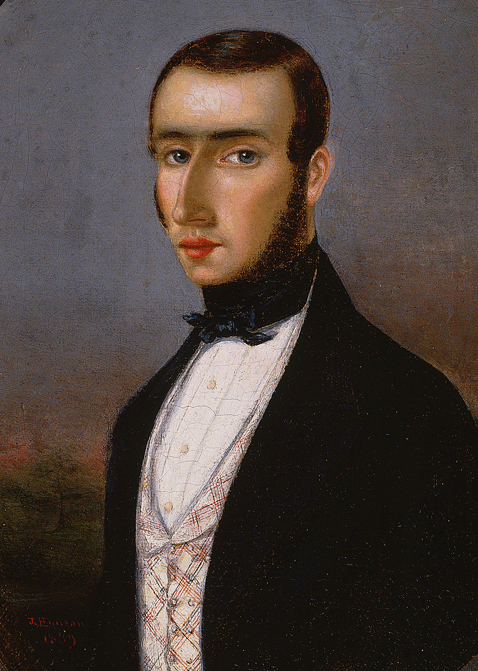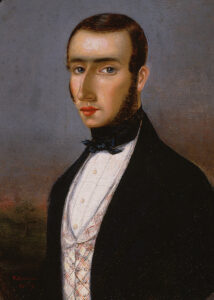Julien Hudson
Julien Hudson was the first professional African American portraitist in the South.

Courtesy of Louisiana State Museum
Julien Hudson - Self Portrait. Julien Hudson (artist)
A free man of color and New Orleans native, Julien Hudson, was the first professional African American portraitist in the South and the second in the United States, following the more famous Joshua Johnson of Baltimore. Only five portraits by Hudson are known to exist, but his training in European high-style portraiture and his importance as a Louisiana artist are well documented.
Born January 9, 1811, Hudson was the son of John Thomas Hudson, an English ship chandler and ironmonger, and Suzanne Desirée Marcos, a free quadroon. Marcos was the daughter, and Hudson the grandson, of Françoise Leclerc, a freed slave who became a property owner in the French Quarter. Hudson’s maternal relatives were educated, French-speaking Catholics; he and his siblings were baptized at St. Louis Cathedral.
At thirteen, he was apprenticed to a local tailor, but soon found his true calling when, in 1826, he studied painting with Italian miniaturist Antonio Meucci. With a legacy from his grandmother, he continued his art studies in Paris during 1830 and 1831. On his return to New Orleans in 1831, Hudson advertised his services as a miniaturist; his studio was in his mother’s house on Bienville Street. Surviving portraits from that period include an 1834 painting of a blonde girl with a rose, now in the collection of the Ziegler Museum. Two portraits, both painted in 1835, are currently in private collections: one of a boy with a butterfly and another of a bearded man with a red turban.
In 1837 Hudson studied in Paris with Alexandre Denis Abel de Pujol. Later that year, he listed himself as a portrait painter in New Orleans, where he also taught students such as George David Coulon. Two later portraits are extant: Jean Michel Fortier III and a young man with a plaid vest, both in the collections of the Louisiana State Museum. Hudson’s career ended in 1844 when he died at age of thirty-three.
The known portraits by Hudson depict clearly individualized subjects, painted in oil on canvas, dated and signed “J. Hudson.” The background in four of the paintings is a hazy gray-blue sky and open countryside, reflecting an idealized landscape rather than Hudson’s urban reality. Only the Fortier portrait is an interior. No one knows how many more portraits Hudson painted or the general nature of his clientele.
The community of free people of color in antebellum New Orleans enjoyed privileges and opportunities unthinkable in the rest of the slave-holding South. Like Florville Foy, Jules Lion, and a handful of others, Hudson was able to survive as a professional artist. Only in New Orleans could an African American have formally studied painting, become a portraitist, and taught aspiring white artists. Julien Hudson was a pioneering figure in American art history.
